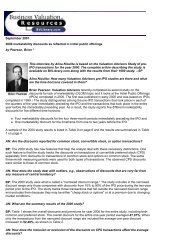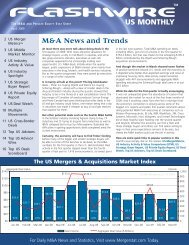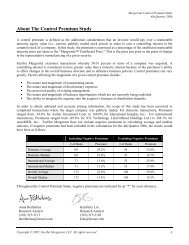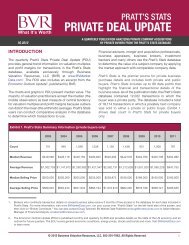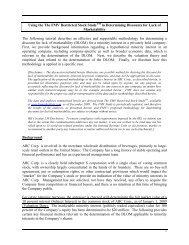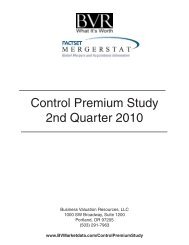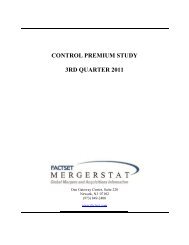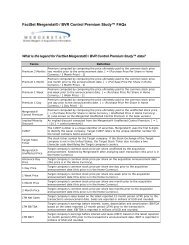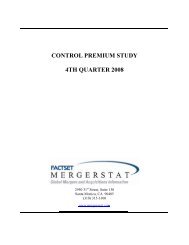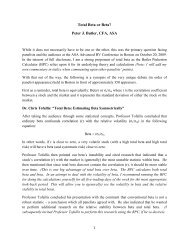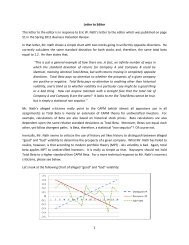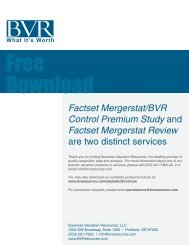TOTAL BETA: WHO'S RIGHT, WHO'S WRONG ... - BVMarketData
TOTAL BETA: WHO'S RIGHT, WHO'S WRONG ... - BVMarketData
TOTAL BETA: WHO'S RIGHT, WHO'S WRONG ... - BVMarketData
You also want an ePaper? Increase the reach of your titles
YUMPU automatically turns print PDFs into web optimized ePapers that Google loves.
Checkpoint Contents<br />
Tax News<br />
Journal Preview (WG&L)<br />
Valuation Strategies (WG&L)<br />
<strong>TOTAL</strong> <strong>BETA</strong>: <strong>WHO'S</strong> <strong>RIGHT</strong>, <strong>WHO'S</strong> <strong>WRONG</strong>, Valuation Strategies (WG&L)<br />
<strong>TOTAL</strong> <strong>BETA</strong><br />
<strong>TOTAL</strong> <strong>BETA</strong>: <strong>WHO'S</strong> <strong>RIGHT</strong>, <strong>WHO'S</strong> <strong>WRONG</strong><br />
Sometime between the third and fourth editions of the Cost of Capital,<br />
Pratt and Grabowski appear to have had a change of heart regarding total<br />
beta.<br />
Author: PETER J. BUTLER<br />
PETER J. BUTLER, CFA, ASA, MBA, is the principal of Valtrend, LLC.<br />
The fourth edition of Pratt and Grabowski's Cost of Capital 1 undoubtedly is an<br />
outstanding contribution to our body of knowledge. Yet some portions of Chapter 15,<br />
titled “Company-Specific Risk,” are misguided. Unquestionably, there is confusion<br />
regarding total beta in the appraisal profession. Surprisingly, however, a comparison of<br />
the criticisms of total beta in the newest edition of the Cost of Capital to the coverage this<br />
issue received in the previous edition indicates that even Pratt and Grabowski appear to<br />
be confused about the topic.<br />
Total Beta<br />
Total beta is the relative standard deviation between a stock and the market. It is used to<br />
capture total risk. Privately-held companies are often valued (and priced) as stand-alone<br />
assets with total risk in mind. Total risk is generally priced in private markets because of<br />
prospective business owners' inability to shed company-specific risk (CSR) due to a lack<br />
of diversification. According to traditional financial theory, only systematic risk is priced in<br />
the public markets because investors have the ability to shed CSR.<br />
ln the present author's opinion, a total beta perspective is better at assigning a private<br />
company's cost of capital than the standard build-up method because it allows appraisers<br />
to compare and contrast specific public guidelines with private companies as opposed to<br />
building up the rate (from averages) and then making a guess as to the appropriate<br />
company specific risk premium (CSRP). ln short, total beta gives appraisers empirical<br />
evidence that did not exist before.<br />
Discrepancies Between the third and fourth Editions<br />
A highlight from the third edition of Cost of Capital states:<br />
In this chapter we discuss approaches to better quantify the total risk and<br />
related market returns of guideline companies. When you use the total<br />
risk and the related return, you are including company-specific risk. 2
The third edition then described the use of total beta as one of the better approaches to<br />
quantifying total risk.<br />
In the fourth edition, however, it is stated:<br />
No researcher studying whether the market prices unsystematic risk or the<br />
magnitude of that pricing has used E(R i ) = R f +(TB × RP m ). 3<br />
The equation above is the total cost of equity (TCOE) equation developed by New York<br />
University Professor Aswath Damodaran. This equation replaces the CAPM beta with total<br />
beta for private company valuation. In the fourth edition, Pratt and Grabowski imply that<br />
they believe that the theory is flawed. But the statement from the fourth edition was<br />
certainly true when the third edition was written, so why the change of heart<br />
This article will analyze criticisms against total beta and the Butler Pinkerton Calculator<br />
(BPC) 4 with the goal of allowing the readers to determine if those criticisms are wrong,<br />
unfair, 5 or potentially biased.<br />
Background<br />
The 2011 study material for the Chartered Financial Analyst program states:<br />
[W]e can assume that in an efficient market, no incremental reward can<br />
be earned for taking on diversifiable risk. [Emphasis added.]<br />
This is an obvious point. All appraisers know, however, that markets may not be perfectly<br />
efficient. In the fourth edition of Cost of Capital, Pratt and Grabowski point to research<br />
indicating that CSR may be priced—at least on some level—in the public markets. If true,<br />
do the public markets completely price CSR (which is what total beta does) The present<br />
author does not believe so, finding it hard to accept that someone can create a well<br />
diversified portfolio with only (or mostly) systematic risk, yet would be compensated<br />
completely for all CSR that they no longer have, or have only in immaterial amounts.<br />
That would be a nice deal if one could get it, but no one can. In short, even if CSR is<br />
priced in the public markets, it is not priced completely.<br />
Total beta, on the other hand, prices CSR completely. In fact, it completely prices total<br />
risk. That is the reason that no academic researcher has used total beta and the total<br />
cost of equity (TCOE) calculation set out earlier. If a researcher used total beta, he or she<br />
would obviously think that diversification was of no benefit whatsoever. (Try to get that<br />
hypothesis published somewhere.) Researchers do not use total beta to describe public<br />
stock returns because they know that CSR is not completely priced in that market. We<br />
proponents merely use it as a proxy for private company returns where CSR is priced due<br />
to lack of diversification.<br />
Unfair, Incorrect, or Inconsistent Criticisms<br />
Pratt and Grabowski make unfair, incorrect, or inconsistent criticisms about total beta<br />
results. These criticisms are examined below.<br />
Two costs of capital.
Prat and Grabowski claim that total beta results in the “unreasonable position” that there<br />
are at least two costs of capital for a business:<br />
(1) The cost of capital for investors (i.e., the pool of potential buyers), who are<br />
likely to be diversified.<br />
(2) The cost of capital to the current owner, who is completely undiversified. 6<br />
This claim is disputable. First, cost of capital has always been about the pool of potential<br />
buyers. Second, why is it assumed that the pool of buyers is likely to be diversified for<br />
every engagement How many potential business owners are well diversified after<br />
purchasing a privately held company Not many.<br />
Guessing at diversification.<br />
Prat and Grabowski ask “how can a company estimate its cost of capital if it needs to<br />
guess if the pool of likely buyers is diversified” 7 Simply stated, a company need not<br />
guess, at least not in most instances. Traditionally, privately held companies are valued<br />
as stand-alone assets and priced on total risk, whereas public companies are priced only<br />
(or primarily) on systematic risk. This is why appraisers add company-specific risk<br />
premiums (CSRP) in the build-up approach, and not, as Pratt and Grabowski surmise,<br />
because investors view a private company's risk differently than the average risk<br />
characteristics of a pure play guideline public company to which it would be compared.<br />
Pratt and Grabowski's view is an affront to modern portfolio theory, which is based on the<br />
ability to diversify away all (or most) CSRs. Most private business owners simply do not<br />
have this ability. In addition, Pratt and Grabowski do not tell readers what they mean by<br />
a “pure play guideline company.”<br />
Total beta, however, is not appropriate in all circumstances. For example, if a company is<br />
being acquired by a public company, is going public, or is large enough to be publicly<br />
owned, an appraiser should use the capital asset pricing model (CAPM) beta. Total beta<br />
also may not be appropriate if an appraiser determines that a pool of buyers is somewhat<br />
diversified. This situation may require a “private company beta.” 8 A private company<br />
beta exists somewhere between a CAPM beta, in which only systematic risk is priced, and<br />
total beta, in which total risk is priced. Of course, certain assumptions will have to be<br />
made, but it is far more empirical than merely guessing at an appropriate (adjusted<br />
downward) CSRP in the build-up method to account for some level of diversification. 9<br />
Total Beta violates FMV and FV.<br />
Pratt and Grabowski suggest that total beta violates the definitions of fair market value<br />
(FMV) and fair value (FV). 10 The present author strongly disagrees. In fact, total beta no<br />
more violates FMV or FV than the build-up method, in which an appraiser has subjectively<br />
added a CSRP due to lack of diversification. Appraisers do not have a specific investor in<br />
mind, other than assuming that the investor is (generally) undiversified. If an appraiser<br />
does not add a CSRP, then he or she has made the determination that the likely buyer is<br />
diversified. Does this violate the FMV or FV standard Of course not.<br />
Cost of capital is a function of the investment, not the<br />
investor.<br />
Pratt and Grabowski claim that the cost of capital is a function of the investment, and not<br />
the investor. On the same page, however, they also claim that “as the more diversified
uyer is likely to pay a higher price, the value of the business and business interests in<br />
most cases must be greater than their value determined using total beta.” 11 Which is it<br />
Admittedly, the investor matters, and cost of capital is not just about the investment.<br />
This is modern portfolio theory in action, which gave rise to total beta. In short, if a buyer<br />
is diversified, an appraiser should use beta (private company beta), not total beta. If,<br />
however, the buyer lacks diversification, total beta should be used. Pratt and Grabowksi<br />
appear to be saying one thing, when they really mean something else (which happens to<br />
be consistent with total beta).<br />
In sum, marginal investors set the price, and the cost of capital is a function of both the<br />
investment and the investor. An appraiser must assume that he or she is dealing with<br />
well diversified investors in the public markets and nondiversified investors for (most)<br />
private markets. And yes, the investor obviously matters. Thus, one needs to improve<br />
CAPM beta for private company valuation, and total beta or private company beta are<br />
just such improvements.<br />
Small private companies do not have public guidelines.<br />
Grabowski is apparently comfortable with using guideline publicly traded stocks in his<br />
Duff & Phelps Risk Premium Report to assist in the determination of the appropriate cost<br />
of capital for a small privately held company, yet Pratt and Grabowski object to using<br />
publicly traded data in a total beta framework. Either the use of publicly traded stock<br />
data is unacceptable or it is not. Total beta simply provides another metric that a valuator<br />
may use—a metric that captures total risk, and therefore systematic risk, size risk, and<br />
CSR, in one fell swoop. In short, total beta offers many advantages.<br />
Total beta includes an embedded discount for lack of<br />
marketability.<br />
Pratt and Grabowski suggest that total beta captures lack of marketability since it<br />
purports to capture total risk, citing, in support, a paper written by Professors<br />
McConaughy and Covrig. 12 Total beta proxies, however, come from publicly traded<br />
stocks. If the stock is efficiently traded (i.e., not thinly traded), there is no concern about<br />
a lack of marketability. If, on the other hand, the guideline is thinly traded, the guideline<br />
should be removed from consideration as a proxy. If Grabowski is concerned about this<br />
issue for total beta, he should be equally concerned for his Duff & Phelps Risk Premium<br />
Report Portfolio 25.<br />
In addition, Professors McConaughy and Covrig are on record as being strong supporters<br />
of total beta and the BPC. 13 Specifically, they state:<br />
We believe that the Butler-Pinkerton Calculator is a useful tool for<br />
appraisers who want a quantitative way to assess the maximum CSRP.<br />
What the Total Beta and calculator computes is the maximum or upper<br />
bound for the CSRP. A good appraisal should also use subjective<br />
techniques and judgment to determine the appropriate CSRP for the<br />
subject company.<br />
Too many factors, too few guidelines for using total beta<br />
or the BPC.
Pratt and Grabowski claim that there may be too many risk factors to consider, or too few<br />
guidelines, to use total beta or the BPC. If an appraiser uses the CAPM, he or she has to<br />
select guidelines. If the market approach is used, the appraiser has to select guidelines.<br />
If an appraiser calculates a discount for lack of marketability (DLOM), the courts prefer<br />
that the appraiser use guidelines and not averages. Guidelines, of course, are never<br />
perfect, but appraisers do the best they can do with what they have.<br />
The build-up method, however, simply uses averages for the industry risk premium and<br />
size premium. Moreover, the build-up method has neither averages nor guidelines for<br />
CSR. So even if there was only one guideline to help select a total beta for a particular<br />
privately held company, it would be far better than no guidelines. There is no data on<br />
CSR if the appraiser only makes an educated guess under the build-up method.<br />
If an appraiser is comfortable using only the build-up method, he or she must also<br />
consider that courts find in the company-specific risk premium the means by which<br />
appraisers can provide final results that neatly support their clients' objectives when<br />
other valuation inputs fail to do the trick. 14<br />
CSRP is an aggregate calculation; subjectivity remains.<br />
Carefully comparing guidelines to a subject company is a subjective exercise. This is<br />
positive. With total beta, at least an appraiser has relative empirical benchmarks. Thus, it<br />
is much less subjective than a pure guess with no data at all. An appraiser can ignore the<br />
benchmarks and guess at his or her own peril, but many highly qualified appraisers no<br />
longer feel comfortable guessing. As one commentator put it:<br />
Years ago, when I first attended a BPC session at a NACVA conference, I<br />
immediately recognized the BPC as a great step forward for the business<br />
valuation profession. Total Beta and the BPC made so much sense and<br />
represented such an improvement over the totally subjective methods that<br />
I wondered why I had not thought of it myself. Failure to utilize the BPC in<br />
the litigation environment could well be fatal to a Valuation Analyst's<br />
expert career. 15<br />
CSR is a function of the beta estimate, which is subject<br />
to error.<br />
Everything in valuation is subject to “error,” some metrics more than others. Duf &<br />
Phelps Risk Premium Report's use of sum beta is also subject to “error,” but Grabowski<br />
uses sum beta to counter a problem with CAPM beta, noting that “[b]ecause of nonsynchronous<br />
price reactions, the traditional betas estimated by ordinary least squares are<br />
biased down for al but the largest companies.” 16 Total beta, however, already captures<br />
non-synchronous price (i.e., CSR) reactions. If an appraiser does not want to isolate the<br />
CSRP because of worries related to beta or in determining a specific size premium for<br />
each guideline, then he or she should just use total beta. Beta is (generally) more volatile<br />
than total beta due to the volatility of the correlation coefficient.<br />
Many appraisers rely on total beta, which is just the relative standard deviation between<br />
a stock and the market, because it makes for a much easier deposition or crossexamination.<br />
An appraiser who uses total beta has to defend one number (total beta)<br />
rather than other numbers, such as the beta (sum beta) or industry risk premium, the<br />
size premium, and the CSRP.
Total beta quantifies two risks simultaneously.<br />
Pratt and Grabowski claim that total beta simultaneously captures CSR and the lack of<br />
diversification risk of the venture. The present author agrees that these two risks are<br />
inseparable, adding that if, and only if, the venturer lacks proper diversification will CSR<br />
be priced (either completely or partially).<br />
The BPC is not the answer.<br />
Nothing in Chapter 15 of Cost of Capital should make an appraiser second-guess his or<br />
her use of total beta or the BPC.<br />
Pratt and Grabowski quote M. Mark Lee for the statement that total beta or the BPC are<br />
not the answers. 17 The present author agrees—total beta or the BPC are not the answers,<br />
but they can assist in finding the “answer” more empiricaly than a pure guess. And in<br />
spite of all of the problems with the build-up method, the present author does not<br />
recommend abandoning it. After all, the more information an appraiser can gather, the<br />
better able he or she will be in determining an appropriate cost of capital for a privately<br />
held company. The present author merely recommends that total beta be part of an<br />
appraiser's toolbox.<br />
Perhaps a better way to think about total beta's eventual adoption is this: If total beta<br />
had been invented before the build-up method, would anyone consider abandoning it to<br />
use the build-up method, which has been described as a “recipe for disaster” 18 by<br />
Professor Damodaran Unlikely. Although not examined here, in addition to a pure guess<br />
on CSR, the build-up method may result in double- and triple-count risks. In short, no<br />
one builds up multiples in the market approach. Rather, an appraiser observes market<br />
multiples and adjusts accordingly for differences between the subject and the guidelines.<br />
It is no different for total beta.<br />
Conclusion<br />
Total beta and the BPC receive negative attention in the fourth edition of Cost of Capital.<br />
Sadly, Pratt and Grabowski reference only naysayers in Chapter 15. 19 The present author<br />
and others, however, have refuted the naysayers' views, and other proponents are<br />
stepping up in defense of total beta. 20<br />
Specifically, a growing number of well regarded, independent appraisers and academics<br />
are debating, publishing and providing positive testimonials about, 21 and defending the<br />
total beta theory. The proponents recognize that total beta is theoretically sound for<br />
private company valuation, is empirically-based, and is a major step forward for the<br />
valuation industry. Clearly they are willing to put their reputations on the line in support<br />
of the technique, so they must believe in it. As Gary Schurman, CFA, stated recently,<br />
“total beta is just the CAPM beta without the benefit of diversification.” 22 It is as simple<br />
as that. It is not controversial for those who are willing to perform their own due<br />
diligence on the topic.<br />
Maybe total beta is a better approach, as the third edition of the Cost of Capital stated.<br />
The alternative, after all, is to guess at CSR, a theory that Pratt and Grabowski are<br />
implicitly promoting. But Pratt and Grabowski have no answer for the harsh indictment of<br />
our industry.
Long and short, if an appraiser uses total beta, he or she will not be alone. In fact, the<br />
appraiser who uses total beta will be in highly regarded company. Ultimately, however,<br />
analysts must dig into the theory, examine its practical applications, and reach their own<br />
conclusions. Appraisers who engage in their own due diligence on total beta will not be<br />
disappointed with the results.<br />
1<br />
2<br />
Grabowski and Pratt, Cost of Capital, 4th ed. (John Wiley & Sons, 2010).<br />
Grabowski and Pratt, Cost of Capital, 3rd ed. (John Wiley & Sons, 2008), at page 226.<br />
[Emphasis added.]<br />
3<br />
4<br />
See note 1, supra, at page 310.<br />
The BPC is a commercial application hosted by Business Valuation Resources on their<br />
website, www.bvmarketdata.com. The BPC calculates guideline betas, total betas, and<br />
TCOEs, among other statistics, for use as benchmarks in private company valuations.<br />
5<br />
For example, can some of these same criticisms also be made about the build-up<br />
method<br />
6<br />
7<br />
8<br />
Cost of Capital, 4th ed., at pages 306 and 307.<br />
Cost of Capital, 4th ed., at page 307.<br />
Butler and Schurman, "A Tale of Two Betas," The Value Examiner (January/February<br />
2011).<br />
9<br />
For more information on private company beta, see the frequently asked questions<br />
under the BPC at www.bvmarketdata.com.<br />
10<br />
Cost of Capital, 4th ed., at page 307.<br />
11<br />
Id.<br />
12<br />
Cost of Capital, 4th ed., at page 308.<br />
13<br />
McConaughy and Covrig, “Comments on Butler-Pinkerton series of papers and Larry<br />
Kasper's “The Butler Pinkerton Model for Company-Specific Risk—A Critique,” Business<br />
Valuation Review (Winter 2008).<br />
14<br />
See e.g., Delaware Open MRI Radiology Associates, P.A. v. Howard B. Kessler et al.,<br />
898 A.2d 290 (Del. Ch. 2006).<br />
15<br />
See the testimonial of Paul C. French, III CPA/ABV, CVA, BVAL, under the testimonial<br />
tab, Butler Pinkerton Calculator link, at www.bvmarketdata.com.<br />
16<br />
Ibbotson® Beta Book (Chicago Morningstar, 2006).<br />
17<br />
Cost of Capital, 4th ed., at page 310.<br />
18
Damodaran, "Ruminations on Risk," 2010 AICPA National Business Valuation<br />
Conference, Slide 15.<br />
19<br />
Namely, Kasper, von Helfenstein, and Lee.<br />
20<br />
See the articles tab under Butler Pinkerton Calculator at www.bvmarketdata.com.<br />
21<br />
See the testimonials under the testimonial tab, Butler Pinkerton Calculator link, at<br />
www.bvmarketdata.com.<br />
22<br />
“Gaining Clarity: The Great Debate over Total Beta,” 2010 NACVA CPE Webinar,<br />
available at http://www.nacva.com/ecommerce/product.asppc=10WBV1116.<br />
© 2011 Thomson Reuters/RIA. All rights reserved.



